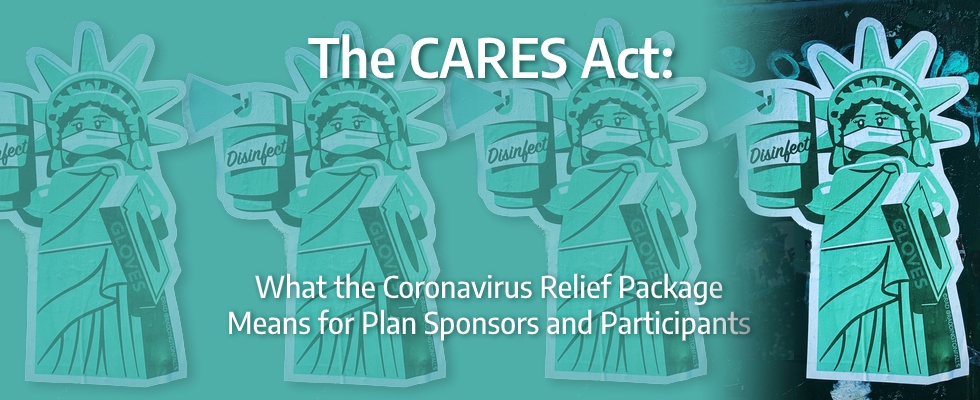
We are all being impacted by the COVID-19 pandemic in one way or another, but many are already feeling the financial burdens associated with it. The CARES Act (Coronavirus Aid, Relief and Economic Security Act), signed into law on March 27, 2020, includes several provisions that give American workers and business owners much-needed financial relief during this difficult time.
The FAQ below provides general answers to the questions most frequently asked by our clients. For more personalized consulting, your Client Relationship Manager is just a phone call way.
F A Q: Click below for answers
★ PARTICIPANT LOANS AND DISTRIBUTIONS
Does the CARES Act provide any changes to participants’ access to plan money?
YES. A qualified participant can take a distribution of up to $100,000 of their vested account balance as well as a loan that does not exceed $100,000 or 100% of their account balance. The plan sponsor has the option of choosing whether they want to provide these options or not.
Who is a qualified participant?
A participant who has been diagnosed with COVID-19 or their spouse or dependent who has been diagnosed with COVID-19. Also, a participant, a participant’s spouse or a household member of a participant who has adverse financial consequences because of the coronavirus such as layoff, reduced working hours, reduction in pay, a job offer rescinded or delayed, or the inability to work due to the loss of child care.
How does the new COVID-19 distribution work?
A qualified participant has until December 30, 2020 to take a distribution. Although the distribution must be reported as taxable income, they can spread it ratably over a 3-year period. Additionally, the distribution will not be subject to the 10% early excise tax. Other good news is that the participant has three years to repay the distribution back to the plan or IRA, as permitted.
How do the expanded COVID-19 loan rules work?
A qualified participant has until September 23, 2020 to take advantage of the increased loan limits. Loan repayments will not have to begin until 2021.
How do I determine if a participant is a qualified participant?
You simply need the participant to self-certify that they meet the requirements of a qualified participant. Recordkeepers are currently updating their online systems to account for these special types of distributions and loans and will likely have the participant certify online.
Or, you can download our COVID-19 Certification Form Template (a .docx file): customize the yellow-highlighted parts, then print it, and have your participant sign it, before you authorize a payment.
When are repayments due for loans taken prior to March 27, 2020?
For qualified individuals, loan repayments due between March 27, 2020 and December 31, 2020 can be delayed for a year. However, loan repayments due in 2021 will not be extended. Therefore loan repayments must begin in 2021, but can be reamortized using the January 1, 2021 loan balance and determining loan repayments based on the extended payoff date (ie. One year after the original payoff date). Some recordkeepers may be able to automate these calculations, however, if not, we can provide the necessary support.
For participants who are not qualified individuals, loan repayments must continue according to their loan repayment schedule to avoid a defaulted loan. However, if a participant is on a leave of absence without pay, loan repayments may be able to be extended.
Please contact our office for assistance with any specific loan situations you need to handle.
★ REQUIRED MINIMUM DISTRIBUTION (RMD) WAIVER
Do participants have to take their required minimum distributions due in 2020 from their retirement plan?
It depends on the type of retirement plan. For retirement plans such as 401(k), 403(b) and profit sharing plans, the participant is not required to take any RMD normally due to be distributed in 2020. This may be helpful to the participant since the market has declined significantly since December 31, 2019. For pension plans such as cash balance and defined benefit plans, no such waiver has been provided.
If the participant already took a required minimum distribution, do they have any special options?
YES. If a participant took a RMD in 2020, they have until the later of August 31, 2020 or 60 days from the date of distribution to roll it back into the plan.
★ CASH BALANCE AND DEFINED BENEFIT PENSION PLANS
What if I am concerned about meeting my funding obligations?
All 2020 funding deadlines have an extended deadline of January 4, 2021. However, there are required interest adjustments for delayed deposits, so you will need to check in with us to make sure you deposit the appropriate amount. Delayed contributions may impact the timing of your tax deduction, so you should take that into consideration and consult with your tax advisor.
What happens if the delayed funding timeline does not help?
We understand that there is likely a lot of uncertainty regarding your business’ cash flow due to the pandemic. There may be options to freeze or amend the benefits provided in your pension plan, which will have the effect of reducing your contribution requirements. Typically this must be done at least 15 days prior to participants working 1,000 hours during the plan year. If this is a concern, you should contact us immediately for personalized advice.
★ SAFE HARBOR 401(K) PLANS
Is there any funding relief for safe harbor 401(k) plans?
NO. The American Retirement Association is currently advocating for relief from the funding of the required safe harbor contributions. However, at this time you are still obligated to make these contributions.
Can I exit from the safe harbor requirements of my 401(k) plan?
YES. Our clients always have this option 30 days after participants are notified of the exit. By exiting the safe harbor feature of your plan, you will reduce the required contributions that must be made, as the contributions will only be based on compensation and deferrals through the date of exit. However, you will lose two key advantages that safe harbor provides:
- (1) Your plan will not automatically pass the ADP/ACP test for the plan year. This means your highly compensated employees may need to have a portion of their 401(k) deferrals returned to them.
- (2) Your plan will not automatically pass the top-heavy test. Therefore, mandatory top-heavy minimum contributions equal to 3% of all non-key participants could be required, which could actually be more expensive than if you had maintained the safe harbor feature.
The decision to exit safe harbor status requires personalized consulting which we can provide. Please contact us if you would like your specifc situation analyzed more closely.


